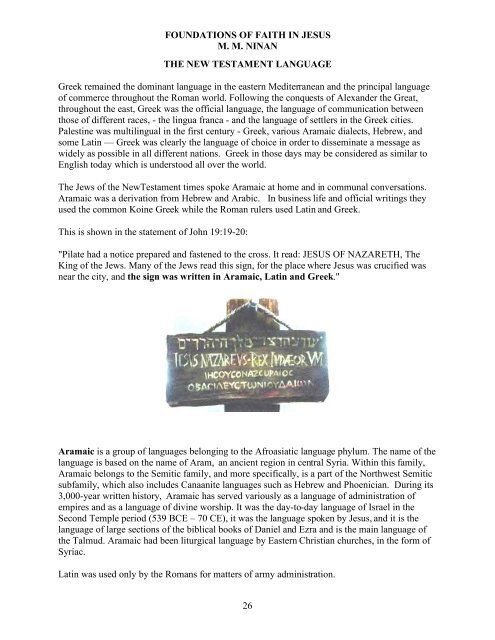Foundations of Faith
Create successful ePaper yourself
Turn your PDF publications into a flip-book with our unique Google optimized e-Paper software.
FOUNDATIONS OF FAITH IN JESUS<br />
M. M. NINAN<br />
THE NEW TESTAMENT LANGUAGE<br />
Greek remained the dominant language in the eastern Mediterranean and the principal language<br />
<strong>of</strong> commerce throughout the Roman world. Following the conquests <strong>of</strong> Alexander the Great,<br />
throughout the east, Greek was the <strong>of</strong>ficial language, the language <strong>of</strong> communication between<br />
those <strong>of</strong> different races, - the lingua franca - and the language <strong>of</strong> settlers in the Greek cities.<br />
Palestine was multilingual in the first century - Greek, various Aramaic dialects, Hebrew, and<br />
some Latin — Greek was clearly the language <strong>of</strong> choice in order to disseminate a message as<br />
widely as possible in all different nations. Greek in those days may be considered as similar to<br />
English today which is understood all over the world.<br />
The Jews <strong>of</strong> the NewTestament times spoke Aramaic at home and in communal conversations.<br />
Aramaic was a derivation from Hebrew and Arabic. In business life and <strong>of</strong>ficial writings they<br />
used the common Koine Greek while the Roman rulers used Latin and Greek.<br />
This is shown in the statement <strong>of</strong> John 19:19-20:<br />
"Pilate had a notice prepared and fastened to the cross. It read: JESUS OF NAZARETH, The<br />
King <strong>of</strong> the Jews. Many <strong>of</strong> the Jews read this sign, for the place where Jesus was crucified was<br />
near the city, and the sign was written in Aramaic, Latin and Greek."<br />
Aramaic is a group <strong>of</strong> languages belonging to the Afroasiatic language phylum. The name <strong>of</strong> the<br />
language is based on the name <strong>of</strong> Aram, an ancient region in central Syria. Within this family,<br />
Aramaic belongs to the Semitic family, and more specifically, is a part <strong>of</strong> the Northwest Semitic<br />
subfamily, which also includes Canaanite languages such as Hebrew and Phoenician. During its<br />
3,000-year written history, Aramaic has served variously as a language <strong>of</strong> administration <strong>of</strong><br />
empires and as a language <strong>of</strong> divine worship. It was the day-to-day language <strong>of</strong> Israel in the<br />
Second Temple period (539 BCE – 70 CE), it was the language spoken by Jesus, and it is the<br />
language <strong>of</strong> large sections <strong>of</strong> the biblical books <strong>of</strong> Daniel and Ezra and is the main language <strong>of</strong><br />
the Talmud. Aramaic had been liturgical language by Eastern Christian churches, in the form <strong>of</strong><br />
Syriac.<br />
Latin was used only by the Romans for matters <strong>of</strong> army administration.<br />
26


















